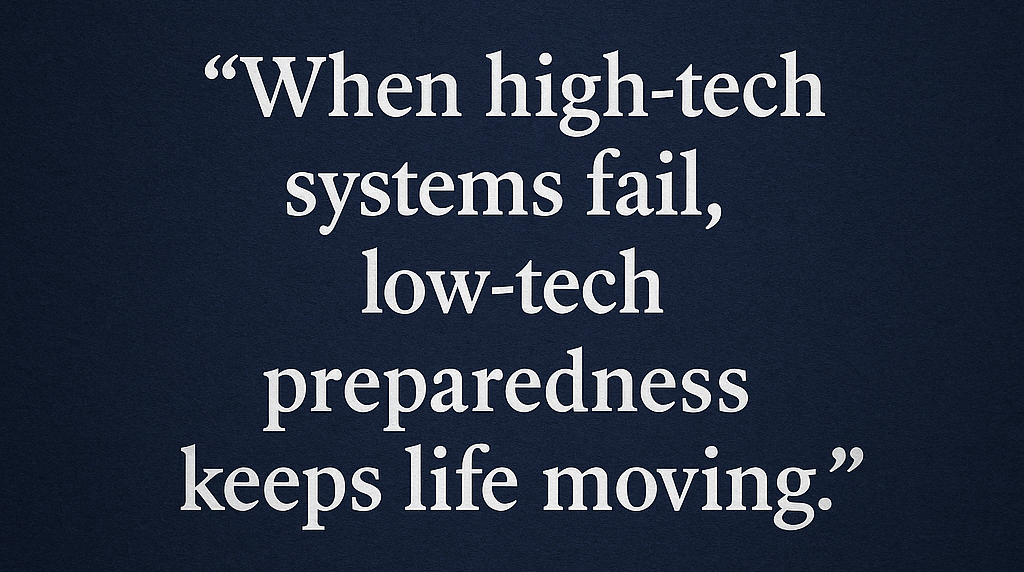Introduction: We live in an age when artificial intelligence (AI) quietly (and sometimes not so quietly) runs behind the scenes of everyday life. AI helps manage power grids, optimize supply chains, drive cars, assist doctors, and even curate what news you see. It’s the invisible hand making modern systems efficient. But what happens when the AI, or technology in general, fails? From benign glitches to catastrophic breakdowns, technological failure is a new kind of threat to prepare for.
In this article, we’ll delve into AI failure scenarios and the broader specter of technological collapse. This isn’t science fiction about robot rebellions—it’s about realistic ways our high-tech infrastructure could falter, whether through accidental failures, cyber attacks, or cascading errors. For preppers, the topic is especially important: it’s about how to cope when the smart systems we rely on go dark or betray us. We’ll cover potential scenarios, historical examples of tech failures, and practical steps to be resilient in the face of an AI or tech meltdown. Technology promises great benefits, but as preppers, we always ask: “What if it goes wrong?” Let’s find out and be ready.

The Silent Backbone: How AI Powers Our World
First, let’s understand just how woven into society AI and complex technologies are:
- Power and Utilities: Modern electrical grids are managed by sophisticated software, some incorporating AI for demand forecasting and automatic adjustments. Water treatment plants, traffic light systems, and pipelines use automated control systems (SCADA systems) that increasingly have AI or algorithmic optimizations. These systems make decisions in real-time to keep everything running smoothly.
- Transportation: From airlines to public transit to shipping logistics, algorithms decide scheduling, routing, and safety checks. Self-driving cars are on the roads in some cities. AI aids air traffic control and even shipping ports use AI to manage container movements.
- Finance and Economy: High-frequency trading algorithms move billions in stocks in microseconds. Banks use AI for fraud detection, loan approvals, customer service (chatbots), and more. The supply chain that stocks our stores is optimized by AI predicting consumer demand and directing goods where needed just-in-time.
- Communication and Information: Spam filters, content recommendation engines, and search algorithms (hello Google) are all AI. They decide what information flows to whom. Automated systems keep the internet itself working (routing protocols, network management that might use AI to detect faults).
- Healthcare and Emergency Services: AI helps in diagnosing diseases, managing patient data, and even dispatching emergency services (some cities use algorithms to allocate ambulances or police patrols to areas). During disasters, agencies may use AI to model and predict crisis needs.
- Daily Life Gadgets: Our smartphones, smart homes with IoT (Internet of Things) devices, virtual assistants (Alexa, Siri), etc., all rely on cloud AI services to function fully.
In short, AI is the “brains” behind many critical organs of modern civilization. Much of the time, this works wonderfully and we hardly notice. But it also means there are new failure modes. A bug in one piece of code, or a malicious exploit of an AI system, could have far-reaching consequences—much faster and wider than traditional failures. Preppers historically worry about things like EMPs, pandemics, or natural disasters. We now must add “tech collapse” to the list of realistic scenarios.
Scenario 1: Grid Down 2.0 (AI-Driven Power Grid Failure)
Consider a scenario: An artificial intelligence system is in charge of balancing the load in a national power grid. It’s been trained to route electricity efficiently, anticipate surges, and even isolate parts of the grid during problems. One day, due to either a software bug or a cyberattack introducing malicious code, the AI malfunctions. Instead of load-balancing, it starts misrouting power or fails to cut off a cascading problem. Within minutes, major transmission lines trip, and the failure ripples across multiple states.
This isn’t far-fetched. We’ve seen how software errors can cause blackouts: for example, the 2003 Northeast Blackout (affecting 50 million people) was triggered in part by a software bug in an alarm system that left operators unaware of grid issues. That was two decades ago, with simpler software. Today’s grids are more automated than ever. An AI glitch could similarly lead to a cascade of outages before humans can intervene.
Now throw in the possibility of a cyberattack: A hacker could target the AI or automation systems that control the grid. In a worst-case scenario, they trick the AI into misreading data or simply shut it down. We already saw an example in 2021, when the Colonial Pipeline (fuel pipeline, not electric grid) was hit by ransomware and taken offline, causing fuel shortages and panic buying in multiple states. The lesson there was that a single pipeline’s IT failure had national impact. For the grid, it could be even bigger.
Consequences: A widespread grid failure from an AI collapse would look similar on the ground to a severe solar storm or EMP: power outage across one or several regions. Without power, everything grinds to a halt—no lights, no HVAC, factories stop, communications towers die after backup power runs out, etc. What makes the AI scenario tricky is that the failure might be hard to diagnose and fix if it’s caused by complex software or a persistent cyberattack. It might not be as simple as repairing a downed line; engineers could be scratching their heads at why the system isn’t stabilizing. Recovery could be slow, especially if physical equipment gets damaged in the process (e.g., overloaded transformers burn out, much like in other grid-down scenarios).
Prepper Angle: Preparing for this is essentially the same as prepping for a blackout, but potentially a long one. If you’ve followed the guidance in the previous article about solar storms or any grid-down prep, you’re on the right track. Key items: backup generators, fuel, solar chargers, battery banks, non-electric alternatives for heating/cooking, etc. One additional consideration: such a scenario might come with no warning. At least with a solar storm we might know a day in advance. A tech failure could strike on a normal day out of the blue. So resilience and quick adaptation are crucial.
Scenario 2: AI Chaos in the Streets (Transportation & Infrastructure Failures)
Imagine waking up to news that all traffic lights in a major city are malfunctioning. An AI-based system that coordinates traffic signals (yes, those exist) has gone haywire due to an update bug. Some intersections are all green in all directions, others stuck on red. The result: massive gridlock, accidents, and emergency services struggling to move.
Or consider autonomous vehicles—self-driving cars, trucks, delivery drones. If the software network that guides them has a widespread error or hack, you could have vehicles stalling simultaneously or worse, causing collisions. A fleet of AI-guided trucks could suddenly stop on highways, snarling logistics.
Another angle: Public transit and railways. Many city metros and train networks use automated control. If an AI signal system fails, trains might all grind to a halt (best case), or end up on collision courses (worst case). In 2003, the U.S. East Coast blackout actually caused New York City’s subways to shut down, stranding thousands. Now imagine a tech collapse causing a similar transport paralysis, even without a power outage.
And then there’s air travel. We’ve had instances where software failures grounded flights—like the 2023 FAA NOTAM system outage that halted all U.S. flights for hours. That wasn’t AI-related per se, but it shows how one system failing can cascade into an entire sector being down. If an AI that manages airline scheduling or air traffic control comms failed, we could see hundreds of flights grounded or misrouted.
Consequences: Transportation failures lead to immediate public safety issues (accidents, people stranded) and if prolonged, supply chain disruptions. If trucks and trains stop moving, stores aren’t restocked, fuel deliveries halt, and essential supplies dwindle in affected areas. If it’s just a city or region, others can send help; but if it’s a nationwide tech glitch (say a common software used everywhere), it could be a real mess.
Prepper Angle: This scenario underscores the importance of having a localized supply of essentials. If roads are jammed or vehicles inoperative, you might be stuck at home or work longer than expected. Have a get-home bag in your car or office with water, comfortable walking shoes, etc., in case you have to hoof it home. Keep some emergency rations in your vehicle. Also, maintain a supply of food and necessities at home that doesn’t rely on just-in-time delivery. The [Link: OmniPrepper Car Emergency Kit Guide] can be useful here. If you normally depend on medications or other things that come via mail-order or distant suppliers, try to keep a little extra on hand.
Scenario 3: Financial Meltdown (AI and the Economy)
The financial system is heavily computerized. Markets can crash in seconds due to programmed trading gone awry (remember the 2010 “Flash Crash” where the Dow plunged nearly 1,000 points in minutes, likely exacerbated by algorithms). Now, AI systems run many investment funds and stock trading algorithms. They also help manage inventory and supply for companies worldwide.
Consider if an AI-driven trading algorithm misbehaves or is manipulated. It could trigger a sell-off that spirals out of control before circuit breakers halt trading. If confidence is shaken, markets might stay closed for days. The ripple effect: banks under stress, credit markets freezing, ATMs possibly limiting withdrawals.
Or, think of a more direct tech fail: a major payment processing network bug. If systems like Visa/Mastercard networks, or digital payment apps, go down simultaneously (maybe due to a faulty AI-based update), millions might suddenly be unable to use credit or debit cards. Retail commerce could freeze up at stores (“cash only” signs appearing everywhere) until the issue resolves.
We should also mention cryptocurrencies and digital assets: Many people have wealth in these, and those markets are entirely tech-based. An AI bug in crypto exchanges or a coordinated cyberattack could see exchanges offline, or erroneous transactions causing panic.
Consequences: A tech-triggered financial meltdown combines an economic crisis with a tech crisis. People might lose trust in digital banking, leading to bank runs (trying to pull cash out). If widespread, it could devolve into a scenario where normal commerce is interrupted. Imagine not being able to buy groceries because the point-of-sale system is down or your bank card doesn’t work. If such a crisis lasted more than a short time, government might declare bank holidays or suspend trading—adding to public panic.
Prepper Angle: Financial preparedness is a piece of the puzzle often overlooked. Some steps to mitigate this:
- Keep some cash on hand. In a tech failure, cash is king for immediate needs. Small bills especially, because if digital systems fail, making change might be hard.
- Diversify access to funds. Don’t rely on a single bank or card. Keep backups (multiple accounts, some physical store of wealth like silver/gold if that’s your style, cryptocurrency wallets you control offline on hardware wallets, etc.).
- Know how to navigate a short-term commerce breakdown. This could mean having supplies to barter, or simply having enough food and fuel so you don’t need to engage in commerce during the crisis. If stores can’t process payments for a week, can you manage without buying anything?
- Critical documents & records: If an AI glitch wipes or locks financial records, you’ll want proof of what you had. Keep paper copies or offline digital backups of key documents: account statements, loan documents, identification, etc. This is more for recovery after things come back online, to sort out any discrepancies.
Scenario 4: Cyber War and AI as a Weapon
There’s a darker scenario where AI doesn’t just fail on its own—it’s turned against us by malicious actors. This might overlap with cyberattack scenarios preppers have discussed, but AI amplifies the threat:
- AI-Powered Cyberattacks: Hackers are starting to use AI to find vulnerabilities and automate attacks. AI can also craft extremely convincing phishing scams. On a larger scale, an AI could learn how to take down infrastructure more efficiently than any human hacker. If, say, a nation-state deployed an AI to attack another country’s power grid or financial system, the speed and scale of such an attack could outpace our usual defenses.
- Deepfakes & Misinformation: AI-generated fake videos or audio could create chaos by spreading false information that appears real. Imagine deepfake messages from government officials ordering evacuations or announcing false emergencies. In a tense situation, that could spur panic or misdirect responders.
- Autonomous Drones or Weapons Gone Wrong: Many militaries are developing AI-driven drones and robotic systems. If communications are hacked or the AI misidentifies targets, those systems could do unintended damage. While that might seem more battlefield-specific, if it happened on home soil (e.g., a drone strike glitch in a domestic area), it becomes a disaster scenario for civilians.
- AI-Controlled Disease Response or Biotech: This is a niche scenario, but if AI is used in laboratories or in disease control (say, managing a containment system in a lab or guiding public health responses), a failure there could potentially release something dangerous or mismanage a crisis.
Consequences: Cyber war with AI could cause any of the previous scenarios—power outages, financial crashes, etc.—but as an attack, likely in combination and targeted for maximal disruption. Additionally, the misinformation angle could cause people to mistrust official communications during the emergency. If deepfake alerts were being spread, you might not know which news is real. Social unrest could be triggered by fake narratives pumped out by bots. We saw a mild version of this with online misinformation during elections and pandemics; an AI pushing disinformation during a panic could be even more destabilizing.
Prepper Angle: This is complex, but some approaches:
- Digital Hygiene: Basic cyber preparedness—use strong, unique passwords (a password manager helps), enable multi-factor authentication, keep your software updated to patch vulnerabilities. These steps help you not be the easy victim in an attack. While you can’t single-handedly stop a grid cyberattack, you can at least protect your personal devices and data.
- Communications Plan: If official channels can’t be trusted or are knocked out, have a way to get information. A good old battery radio is less likely to be faked (though one could hijack a radio station, it’s harder). Being connected with a community of other preppers or HAM radio operators means you can cross-verify info. Have agreed family plans for emergencies that don’t rely solely on getting an official text alert.
- Backup the Backups: Keep offline copies of important data (medical records, contacts, etc.) in case cloud services or computers are wiped by malware. Use external hard drives or USBs stored safely (and consider a Faraday cage for those backups too, to cover EMP scenarios at the same time).
- Be Ready to Disconnect: In some situations, the safest move might be to disconnect your home devices from the internet until the “all clear.” For instance, if a massive cyberattack is in play, you don’t want your personal computer or IoT fridge to become part of a botnet or worse, start malfunctioning. Know how to isolate and operate without smart features. Preppers who keep analog alternatives (like physical maps vs. GPS, printed phone lists, etc.) will fare better if the digital realm is under assault.
Living in a High-Tech, Fragile World: Mindset and Preparations
It’s a paradox: our advanced society is both highly capable and highly fragile. Efficiency has increased, but redundancy has often decreased. Here’s some general guidance for preppers concerning tech collapse:
- Embrace Analog: Make sure you have analog alternatives for critical needs. Examples: a landline phone (old copper line if available) or satellite phone as backup to cellular; a paper map in case GPS is out; physical books and references (like a medical first aid book) in case online resources vanish; non-electric tools (hand pump for water well, manual can opener, etc.). Living a fully smart, connected life is convenient—but have a way to operate in “dumb mode” when needed.
- Practice Digital Detox Drills: Try spending a weekend with the Wi-Fi router turned off, or your phone on airplane mode. See what challenges you face. Can you entertain yourself? Cook from scratch without an online recipe? Contact friends without using your smartphone? These mini-exercises reveal our hidden dependencies and help us prepare psychologically for a tech-free period.
- Stay Informed but Skeptical: Keep up with tech news. If there are warnings about certain AI systems or vulnerabilities (for instance, authorities sometimes issue alerts about new cyber threats), note those. But also be ready to question information during a crisis. If something sounds implausible or extremely sensational, double-check via multiple sources. Don’t fall prey to misinformation, and conversely, don’t dismiss an authentic warning just because it’s delivered unconventionally. It’s a fine balance.
- Skill Up: Learn basic DIY skills that our grandparents took for granted. If an AI failure or tech collapse takes out the fancy systems, old-school skills shine. Know how to purify water, cook on an open flame, navigate without GPS, start a fire, treat minor injuries without Google, etc. The less you need high-tech, the less a tech collapse affects you.
- Community and Low-Tech Networks: In a tech failure, human networks become vital. Build relationships with neighbors and local community groups. Perhaps have a plan with neighbors: if phones don’t work, maybe meet at the local school or church at noon to share info. Old community bulletin boards or ham radio meetups become news hubs. Being plugged into a preparedness group (online now, but potentially in-person if net is down) can provide mutual support when systems are down.

Conclusion: Tomorrow’s High-Tech is Yesterday’s Prep Opportunity
The scenarios above might sound complicated, but at their core, they all lead to one thing: life temporarily (or permanently) off the technological pedestal. Whether it’s due to an AI error, a cyberattack, or cascading tech collapses, the outcome for individuals is similar to many disaster scenarios—loss of services, potential chaos, and a need for self-reliance.
The good news for preppers is that prepping for technological collapse aligns with prepping for other crises. Your stored food doesn’t care if the cause is a hurricane or a server meltdown—it will feed you either way. Your backup solar battery bank will charge your devices whether the grid is down from a cyberattack or a solar flare. The overlaps are significant.
However, thinking specifically about AI and tech failures does highlight certain tasks: make sure to backup data, keep cash, maintain analog options, and perhaps don’t put 100% of your trust in any one automated system.
We should also remember that technology is a tool. As preppers, we don’t shun it—quite the opposite, many of us enjoy fancy gadgets like solar generators, ham radios, and water purification tech. But we always ask, what if that tool fails? So have a plan B (and C).
By understanding AI failure scenarios, you’re not only preparing for those specific events, you’re also becoming more resilient in general. You’ll be the person who isn’t thrown into panic when the cell network goes down or the bank website is offline, because you anticipated such possibilities and have a fallback.
In a world racing towards more automation, the wise will quietly prepare for automation’s occasional crash. Think of it as having a spare tire for the road trip of modern life.
Stay alert, stay prepared, and remember: no matter how advanced society becomes, the basics of survival remain food, water, shelter, community, and mindset. Keep those fundamentals solid, and you’ll be ready even if we wake up to a technological hiccup—or catastrophe.
If you found this insightful, check out more articles and guides on OmniPrepper.com. From digital preparedness to good old-fashioned homesteading skills, OmniPrepper is here to help you navigate the high-tech world with a preparedness mindset. Technology may fail, but your preparedness will not—let’s forge a resilient future together.




